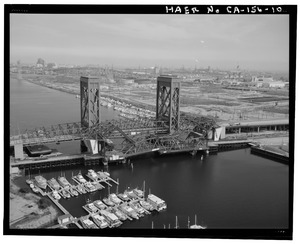Commodore Schuyler F. Heim Bridge facts for kids
Quick facts for kids Commodore Schuyler F. Heim Bridge |
|
|---|---|

Schuyler Heim Bridge (1948), foreground (green structure); and Henry Ford Bridge (1996), background (gray structure). Photographed in 2014, during construction of the replacement road span.
|
|
| Coordinates | 33°45′58″N 118°14′23″W / 33.766111°N 118.239722°W |
| Carries | |
| Crosses | Cerritos Channel, Port of Los Angeles |
| Locale | Wilmington, California |
| NBI | 53-2618 |
| Characteristics | |
| Design | Through-truss vertical-lift bridge |
| Total length | 700 ft (210 m) (4,000 ft including approach viaducts) |
| Width | 81 feet (25 m) (including 75 ft for the six traffic lanes) |
| Height | 236 feet (72 m) tall (186 ft (57 m) above roadway) |
| Longest span | 240 feet (73 m) |
| Clearance below | 175 feet (53 m) fully raised |
| History | |
| Opened | January 10, 1948 |
| Closed | October 12, 2015 |
| Lua error in Module:Location_map at line 420: attempt to index field 'wikibase' (a nil value). | |
The Commodore Schuyler F. Heim Bridge was a vertical-lift bridge in the Port of Los Angeles. Dedicated on January 10, 1948, the bridge allowed State Route 47 (the Terminal Island Freeway) to cross over the Cerritos Channel. Named after Schuyler F. Heim, who was in command of the Naval Air Station on Terminal Island in 1942, the bridge was one of the largest vertical-lift bridges on the West Coast. At the time of its opening, it was the highest in the country with the deck weighing about 820 short tons (740 metric tons). Its towers are 186 feet (57 m) tall above the roadway deck and about 236 feet (72 m) tall when measured from the water level at high water. The bridge was decommissioned on October 12, 2015 and will be replaced by a new, six-lane fixed-span bridge in order to meet current safety and earthquake standards. A replacement bridge, tentatively titled State Route 47 Schuyler Heim Bridge Replacement, was completed in September 2020.
Contents
History
Early connections to Terminal Island
The San Pedro, Los Angeles and Utah Railroad was incorporated on October 8, 1887 with the goal to build a line from Rattlesnake Island (renamed Terminal Island by 1897) near the present site of the Gerald Desmond Bridge.
Since the trestle bridge effectively blocked marine traffic from passing through the east end of Cerritos Slough,
As port traffic increased, plans to widen Cerritos Slough to 1,000 feet (300 m) were advanced in 1914, connecting the Port of Los Angeles to the Port of Long Beach. However, the widened channel would require the newly-renamed Salt Lake Railroad to move its tracks on Terminal Island and remove its 1908 bridge. After several years of negotiation, a compromise was reached.
Despite these early rail bridges, a road bridge was keenly desired by residents of Terminal Island, who had asked for a wagon bridge in 1894
1948 Schuyler Heim vertical-lift bridge
1924 also saw work begin on a Naval Air Base San Pedro at Terminal Island. Port traffic continued to increase and the United States Navy began to expand its presence on Terminal Island in the early 1940s, including an expanded air base. Expansion plans for the Navy called for more workers than could be accommodated over the Henry Ford Bridge, so the Navy commissioned a new road bridge in 1941. Construction on the bridge began in 1946. The Chief Engineer for the project until October 1947 was H. E. Wilson. The bridge was named in honor of Commodore Schuyler Franklin Heim, who was in command of the Naval Air Station on Terminal Island in 1942.
The state of California took over operation of the bridge from the city of Los Angeles in 1964. As of 1988, the bridge was being raised frequently, about 8,500 times per year.
Replacement fixed-span bridge
The State Route 47 Schuyler Heim Bridge Replacement project replaced the liftspan portion of the original bridge with a fixed-span bridge. The replacement bridge has a total of six lanes for vehicular traffic, three in each direction, and span 3⁄4 mile (1.2 km). The new bridge will allow for a permanently navigable shipping channel, 180 ft (55 m) wide with a vertical clearance of 47 ft (14 m). Construction was expected to complete in early 2017, but was delayed to late 2020.
Although the vertical clearance is being reduced from 165 feet (50 m) with the 1948 lift bridge raised to 47 feet (14 m) with the replacement fixed bridge, the lift bridge was already unable to accommodate large cargo ship traffic. Work on the replacement bridge began in 2011 and was finished in September 2020.
Design
The deck of the bridge was an open grid design to decrease weight and ease lifting of the bridge to allow ship traffic to pass underneath. The bridge used >400-short-ton (360-metric-ton) counterweights to lift the deck span portion to allow tall-masted vessels underneath.
State Route 47 and the connecting State Route 103 are heavily used by trucks to bypass part of the crowded Interstate 710 freeway. Due to the large amount of heavy truck traffic over the bridge, the deck was subject to excessive wear. The deck was completely replaced in 1997 but was still under extreme distress. The California Department of Transportation (Caltrans) installed eight experimental fiber reinforced polymer (FRP) panels and attached sensors to test stress, load bearing, and temperature variations of the panels to determine their effectiveness as a permanent replacement. Chicago-based engineering firm CTLGroup installed strain gages and thermocouples within the layers of the FRP. Each month, technicians perform a remote static load test of the bridge, providing direction to onsite Caltrans staff while monitoring real-time data from the firm's Chicago office.


